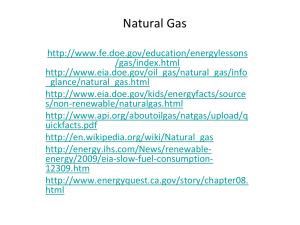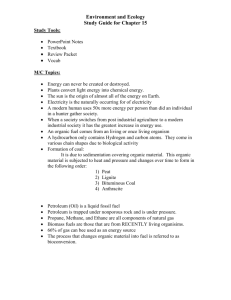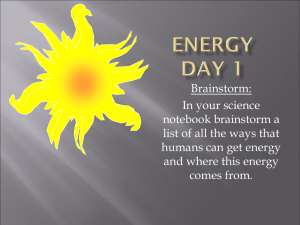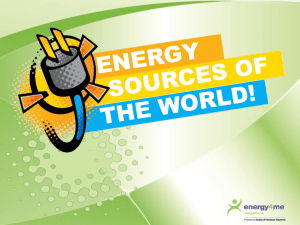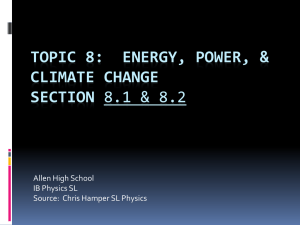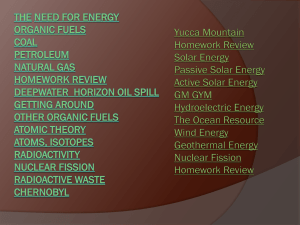Energy From Organic Fuels
advertisement
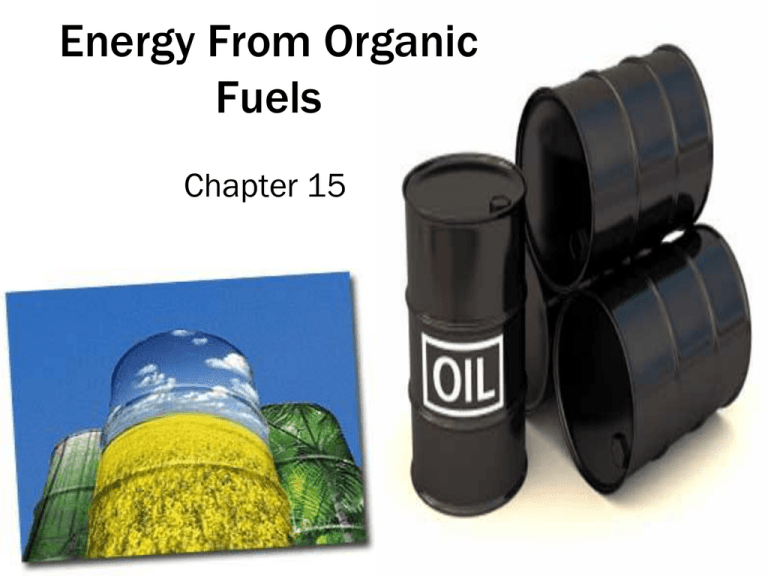
Energy From Organic Fuels Chapter 15 15.1 The Need For Energy • The laws of physics state that energy cannot be created or destroyed. • Light energy from the sun is converted by plants into chemical energy. When we eat food, energy is converted to heat, mechanical energy. •Fuel – any substance from which energy can be obtained. •Energy from the sun fuels almost all life on Earth. •Lightning is the only form of electricity found in nature. Changing Energy Needs Modern industrial society uses about 50 times more energy per person than the hunter-gatherer (Lights, Heat, & Cooking) societies did. Fuels From Organisms • Hydrocarbon – A compound composed only of carbon and hydrogen. • (Methane CH4, Ethane C2H6, Octane C8H18) Naming Hydrocarbons •Fossil Fuels • Fuels derived from the Fossil Fuels remains of organisms that lived long ago. • The energy is stored within buried cells (Animals, Trees, Bones, Plant Roots) of organisms is used as a fuel today. • Petroleum, Coal, and Natural Gas 15.2 Coal • Coal formation is largely the result of sedimentation. • Coal formation occurs in stages over millions of years. • H & O is removed leaving higher concentrations of Carbon. • Higher concentrations of Carbon produces greater amounts of energy. Coal Deposits Peat • The 1st stage in the formation of Coal. • Peat – Brittle, brown plant material containing a great deal of water and a low percentage of carbon. • Large amounts of smoke. • Peat is not coal… yet! Peat Lignite • The 1st form of true coal. • Heat and pressure forces water from the peat forming lignite. • Lignite – Soft, brown coal composed of about 40% Carbon. • Must be mined. Lignite Bituminous Coal • Soft coal composed of up to 85% Carbon. • Most abundant type of coal mined in the US. • Burns hotter and less smoke than lignite and peat. • Used by Power Plants to produce steam to generate electricity. Bituminous Coal Anthracite Coal • Metamorphic Rock formed from Bituminous Coal. • A hard coal composed of up to 95% carbon. • Shiny black color • Located deeper in the ground than other coal forms. • Least amount of water, fewest impurities, and highest carbon content. • Most Expensive = Least Abundant Anthracite Coal 15.3 Petroleum and Natural Gas • Petroleum – Crude oil, liquid fossil fuel. • Natural Gas – Fossil Fuel in gaseous state. • Coal - Solid • Crude oil is under extreme pressure as a result of being trapped under nonporous rocks such as shale. •One of the World’s most important resources. Petroleum •Petroleum Products: Gasoline, Diesel, Fuel oil, Grease, Asphalt, Nylon, Polyester, and Plastics. Natural Gas • Major components of Natural Gas are Hydrocarbons. (Ex. Methane, Ethane, and Propane) • Natural Gas burns cleaner than Coal and Oil. 15.4 Other Organic Fuels • Alternative fuels can solve some but not all of the problems associated with fossil fuels. Problems With Fossil Fuels • Availability – Fossil Fuels are declining (Nonrenewable) • Pollution – Environmental Damage (Oil Spills and Habitat destruction) • Permanent degradation of coastlines are the most serious environmental threats associated with Fossil Fuel exploration. Biomass Fuels • Fuels that are formed from burning recently living organic products. • Biomass Fuel – Fuel formed from the products of living organisms. • Wood, Garbage, Methane, and Alcohol Wood • High concentrations of CO2 and Smoke. • Damages Forests. Garbage • 66% of garbage can be burned as fuel. • Trash to Steam Power Plants Trash to Steam Plant 1 Trash to Steam Plant 2 Trash to Steam Plant 3 Trash to Steam Plant 4 Methane • Family farmers can store animal waste in containers and capture natural gas for fuel. • Swamp gas – naturally produced form of methane. • Methane is being removed from landfills and swamps for fuel usage. Alcohol • Using alcohol fermentation converts organic material into a fuel. (Ethanol) • Bioconversion – Processing organic material into fuel. • Gasohol is a gasoline-alcohol mixture that is being produced by sunflowers and peanuts.


